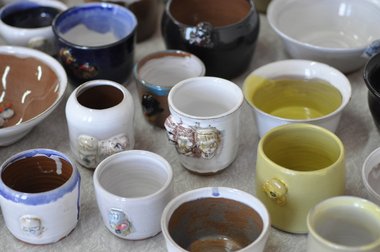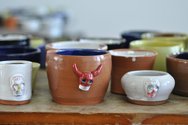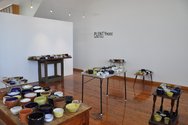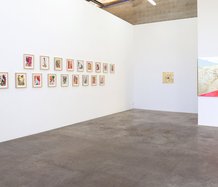Andrew Paul Wood – 31 January, 2012
There is a strong art historical tradition at play here too. In a text accompanying the original showing of these objects at the Tim Melville Gallery in Auckland in November 2011, Youle made reference to the “energy and purpose” of the long table in Leonardo da Vinci's disintegrating Last Supper (1498).
Wayne Youle (Ngā Puhi, Ngāti Whakeeke, Ngāti Pākehā) has in recent years emerged as a potent force in contemporary New Zealand art, working in a surprisingly diverse range of media. His installation Plenty More is cunning, consisting of a number of shonky found tables supporting a panoply of small hand-thrown ceramic bowls. The bowls are individually for sale. Each, as any potter would tell you, is perfectly centred. Each is adorned with the familiar Youle skull motifs moulded into their surface. The glazing however is fascinating, because its deliberately staged half-arsed sloppiness is perfectly executed. The colours are dull, subdued, but expressively and freely applied with precise judgement. These are objects to covet despite their ostensible impression that they were just thoughtlessly dashed off.
As a holistic work, vaguely reminiscent of the groaning trestles of a flea market, it straddles the razorblade divide between art and craft, though it doesn’t pay to get too hung up on the craft aspect. The pots are just individual sculptural objects, and combined form the medium for the idea - a mass of sculptural form analogous to some of the expressions of Arte Povera that, not incidentally, also relate to the Canterbury earthquakes, the loss of fragile objects and the importance we place on accumulated things. There are also, I think, strong resonances with the otherworldly and ephemeral installations of Francis Uprichard.
There is also a strong art historical tradition at play as well. In a text accompanying the original showing of these objects at the Tim Melville Gallery in Auckland in November 2011, Youle made reference to the “energy and purpose” of the long table in Leonardo da Vinci’s disintegrating Last Supper (1498). The idea can also be brought forward to the wonderfully rich and whole still lifes of the Golden Age of Low Countries painting in the 17th century, the hallucinatory and sinister cityscapes of De Chirico, and the still life paintings of Morandi. There is a palpable sense of the Memento Mori and the fragility of life.
The installation sits in striking contrast with Youle’s slick, pulsating outdoor mural I seem to have temporarily misplaced my sense of humour, presented by Christchurch Art Galley a few blocks down the road. The earthquake theme is once more apparent. The mural represents a giant nail board of the kind seen in sheds and garages around the country. It, like them is marked out with the silhouettes of tools - hammers, saws, wrenches - but Youle includes stranger things like a security camera, a classical bust, a small dog. One cannot help but be reminded of Richard Killeen’s cut outs (and given that Youle rarely does anything accidentally, this may well be deliberate). Perhaps these are the special tools needed to fix the soul as well as the body of Christchurch? The “holes” also bring to mind Lichtenstein’s Ben-Day dots.
Neither work, at least to my eye, seems to carry much about it of the playful, often satiric postmodern references to Youle‘s bicultural nature that was so central to earlier work of his - unless, perhaps, it is to be found in the museum-like anthropological collecting and arranging of artefacts. This synthesis and order-seeking is a common feature among our painters and has a resonance with the ‘Kiwi’ fondness for ‘tinkering’ and ‘pottering’. Gregory O’Brien identifies this tendency as a major theme in New Zealand art:
“As well as being a big adventure, a work of art can be a way of storing knowledge, ideas and images. Many New Zealand artists - among them Shane Cotton and W. F. Gordon [1848-1936, in reference to the drawing Trompe l’oeil (1887, Auckland Art Gallery)] - are also collectors, picking up things from the past and present and rearranging them, finding new combinations. According to the Oxford Dictionary of New Zealand English, there is a local word to describe this kind of salvaging and collecting: poozling. That is what Pat Hanly [1932-2004] was doing when he collected symbols of life, wisdom and love in his 1983 painting Wonder Full [Chartwell Collection, Auckland Art Gallery].” (Gregory O’Brien (2008), Back & Beyond: New Zealand Painting for the Young & Curious, Auckland University Press, p11.)
Perhaps one can also allude to similar congregations of images in the work of Tony de Lautour, Séraphine Pick, Bill Hammond, and Shane Cotton. In both installation and mural, accumulation is the central theme, but beyond that, to adopt Saussure’s linguistic trinity of Signifier (vehicle), Signified (that conveyed) and Sign (what comes into being through the association of the other two), the Signifier is Error 404, unavailable for reading or translation, independent from external reality. The enigma, the ambiguity, is all part of the deal.
Andrew Paul Wood
Recent Comments
Raewyn Atkinson
Just to contextual references? How about contemporary ceramics. It is Ehren Tool's signature motif. It refers to skulls, Andrew. It ...
Andrew Paul Wood
I think the skull has lot of it's deeper vanitas associations. Artists seem to prefer using it as a sort ...
John Hurrell
Andrew, I wonder if the skull now is a Sign that has become trite through over-use - like hearts, doves ...



 Two Rooms presents a program of residencies and projects
Two Rooms presents a program of residencies and projects Advertising in this column
Advertising in this column



This Discussion has 8 comments.
Comment
Erin Driessen, 4:30 p.m. 31 January, 2012 #
Nice contextual references, Andrew. Your reference to De Chirico makes me wonder, do you think it is on purpose that both exhibitions are on at the same time? I mean, what is it like to travel the space between the two exhibitions? I'm not familiar with Christchurch and have never stepped foot in The National. Could you say a little more about the surrounding spaces; or if you don't think they are relevant or an influence, could you explain why?
Owen Pratt, 9:17 a.m. 1 February, 2012 #
...maybe a little overcontextualised, with the lob about Morandi. Just because there are pots, and for that matter da Vinci because there's a table?
Erin Driessen, 3:02 p.m. 1 February, 2012 #
But how awesome when 'nothing' objects like these can allude to so much when they're done right - it's no accident that Vermeer pops up too.
Andrew Paul Wood, 4:52 p.m. 1 February, 2012 #
Hi Erin - Coincidence is probably the wrong word, but both works directly reference the earthquakes and Youle is a prominent Canterbury artist. It's definitely a matter of him being in situ. Both gallery and mural are in the light industrial/heavy commercial end of town, which was fairly heavily damaged. I read a shared sense of accumulation of volumes and voids, and a similar existential desolation in De Chirico.
Owen, Da Vinci was Youle's link, and what exactly do you think Morandi was trying to do with the tense psychological dramas of plain old pots and tatty paper flowers? Fragility and accumulation.
Owen Pratt, 7:40 p.m. 1 February, 2012 #
I trust what you see and say Andrew, I hope the show comes to Melville's gallery as I would like to see this for myself.
John Hurrell, 9:38 p.m. 1 February, 2012 #
Andrew, I wonder if the skull now is a Sign that has become trite through over-use - like hearts, doves and rainbows. It is now cute; no longer associated with death or danger, for how many of us in the western world have ever seen directly human bones? Very few. The Signified 'meaning' is very abstract and remote.
Aren't artists who use this Signifier in danger of being perceived as lazy? The image lacks potency and seems to indicate a process of nonthinking? Error 404 notwithstanding.
Andrew Paul Wood, 6:53 p.m. 3 February, 2012 #
I think the skull has lot of it's deeper vanitas associations. Artists seem to prefer using it as a sort of semiotic allusion to pop cultural rebellion and a rock sensibility.
Raewyn Atkinson, 6:08 a.m. 9 February, 2012 #
Just to contextual references? How about contemporary ceramics. It is Ehren Tool's signature motif. It refers to skulls, Andrew. It seems that a knowledge of contemporary ceramics is here considered unnecessary and maybe inappropriate.
Participate
Register to Participate.
Sign in
Sign in to an existing account.